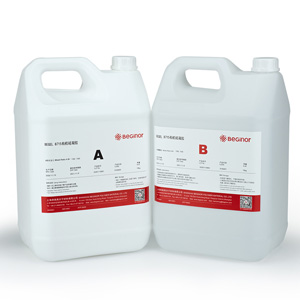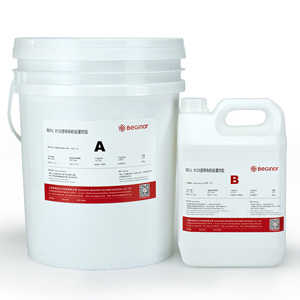Home > Product > Potting Material > Silicone Material > Begel 8707
Begel 8707 A/B 1:1 Clear Two components soft silicone gel elastomer
- Fast room temperature cure
- Elastomer-like toughness
- Protection from moisture, dirt, and other atmosphericcontaminants
- Protection from mechanical stress and strain caused bythermomechanical shock and vibration
- Easy repairability
- Good dielectric properties, even at high frequencies
- No solvents or cure by-products
- Physical and electrical stability over a wide temperaturerange from -40° to 200°C
BeGel 8707 is a two component silicone elastomer that crosslinks at room temperature by polyaddition reaction. The pueolymerisation can be accelerated by heat.
| Appearance | transparent |
| Hardness, Shore A | 6-8 |
| Cone Penetration, ISO 2137 | 150g 35mm |
| Dielectric Strength,KV/mm | 25 |
| Volume Resistivity,Ω·cm | 1.0×1015 |
| Dielectric Constant at 1 MHz | 2.8 |
| Range of Using temperature | – 60 ∽ 200 ℃ |
Used for semiconductor devices
Processing
- Mixing the two components
BeGel 8707 A & B are mixed by weight in a fixed ratio given above.
The two components may be thoroughly mixed either by hand or using a low-speed electric or pneumatic mixer to minimise the introduction of air and to avoid any temperature increase.
Note: It is also possible to use a special mixing and dispensing machine for the two silicone
components.
Further information is available upon request.
2 . Handling
The mixture should be degassed preferably at 30 to 50 mbar to eliminate any entrapped air. If a dispensing machine is used, the two components are degassed separately prior to mixing.
The silicone mixture expands to 3 to 4 times of its initial volume and bubbles rise to the surface .The bubbles progressively disappear and the mixture returns to its initial volume after 2 to 3 minutes. Wait a few minutes to complete the degassing and then flash the vacuum. The silicone is ready for pouring, either by gravity or under low pressure.
Note: Flashing the vacuum once or twice accelerates the degassing. It is recommended to use a container with a high diameter/height ratio(3 to 4 times of the initial volume)
3 . Polymerisation
The system, as indicated in the technical data, polymerises at 25℃ .The curing may be slowed down at lower temperature and contrary accelerated by applying heat.
Note: in general contact with certain materials can inhibit the crosslinking of RTV.
See list below:
- Natural rubbers vulcanised with sulphur
- RTV elastomers catalysed with metal salts,e.g. tin compounds
- PVC stabilised with tin salts and additives
- Epoxy catalysed with amines
- Certain organic solvents, e.g.Ketones, alcohols, ether etc.
[auth-download url=”https://beginor-chemical.com/wp-content/uploads/2019/03/TDS-of-BeGel-8707-silicone-gel.pdf” title=”TDS Download BeSil 8707″]




